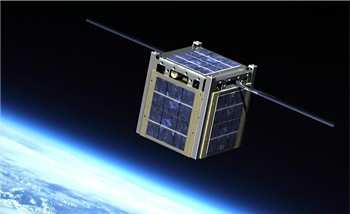Mon, Jul 15, 2013
Three Micro-Thruster Technologies Determined To Have Potential
NASA selected three proposals for the development of lightweight micro-thruster propulsion technologies that are small in size but have big potential. NASA's Space Technology Mission Directorate selected the miniaturized electrospray propulsion technologies to perform stabilization, station keeping and pointing for small spacecraft. NASA hopes these technology demonstrations may lead to similar position control systems for larger spacecraft and satellites as well.

NASA's Game Changing Development Program, managed by the agency's Langley Research Center in Hampton, Va., sponsored this solicitation and will oversee the first phase of this technology development.
The three awards selected for contract negotiations are:
- 'Microfluidic Electrospray Propulsion (MEP)' by NASA's Jet Propulsion Laboratory, Pasadena, CA.
- Miniature ElectroSpray Thrusters Based on Porous Surface Emission' by Busek Company, Inc., Natick, MA.
- 'Scalable ion Electrospray Propulsion System (S-iEPS)' by the Massachusetts Institute of Technology (MIT), Cambridge, MA.
Proposals for this solicitation were received from NASA centers, federally funded research and development centers, universities and industry. At least one electrospray technology will be selected for further development as an in-space flight demonstration through NASA's Small Spacecraft Technology Program during Phase II, which will be made through a separate solicitation.

One of NASA's priorities is to seek and develop new technologies that will radically change the capabilities for small satellites. There currently is a lack of efficient propulsion for a class of low cost, nanosatellite research spacecraft called "Cubesats," which measure about 4 inches on each side and weigh less than 3 pounds. The successful development and demonstration of these miniaturized systems will offer low mass, low-power propulsion for these small spacecraft and potentially revolutionize the future of Cubesats.
Miniaturized electrospray propulsion technologies also signal a revolutionary alternative for position control systems for larger satellites. Several studies have shown that micro-thrusters could replace currently accepted systems on large spacecraft, saving weight and space while significantly increasing mission reliability and lifetimes. This technology also could enable other game changing propulsion capabilities from micro-scale to large, deployable spacecraft structures.
More News
Aero Linx: Commercial Aviation Safety Team (CAST) Founded in 1997, the Commercial Aviation Safety Team (USCAST) has developed an integrated, data-driven strategy to reduce the comm>[...]
Land And Hold Short Operations Operations that include simultaneous takeoffs and landings and/or simultaneous landings when a landing aircraft is able and is instructed by the cont>[...]
We're Everywhere... Thanks To You! Even with the vast resources and incredibly far-reaching scope of the Aero-News Network, every now and then a story that should be reported on sl>[...]
Pilot’s Inadvertent Use Of The Landing Gear Control Handle Instead Of The Flaps Selector Switch During The Landing Rollout Analysis: The pilot reported that during the landin>[...]
Also: Cosmonaut Kicked Out, Airbus Scales Back, AF Silver Star, Russian A-60 Clobbered A Samaritan’s Purse humanitarian flight was hijacked on Tuesday, December 2, while atte>[...]
 ANN's Daily Aero-Linx (12.12.25)
ANN's Daily Aero-Linx (12.12.25) ANN's Daily Aero-Term (12.12.25): Land And Hold Short Operations
ANN's Daily Aero-Term (12.12.25): Land And Hold Short Operations ANN FAQ: How Do I Become A News Spy?
ANN FAQ: How Do I Become A News Spy? NTSB Final Report: Cirrus Design Corp SF50
NTSB Final Report: Cirrus Design Corp SF50 Airborne 12.08.25: Samaritans Purse Hijack, FAA Med Relief, China Rocket Fail
Airborne 12.08.25: Samaritans Purse Hijack, FAA Med Relief, China Rocket Fail




